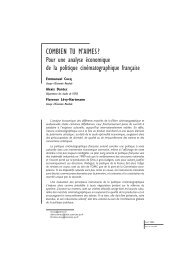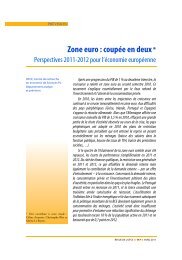direct multi-step estimation and forecasting - OFCE - Sciences Po
direct multi-step estimation and forecasting - OFCE - Sciences Po
direct multi-step estimation and forecasting - OFCE - Sciences Po
You also want an ePaper? Increase the reach of your titles
YUMPU automatically turns print PDFs into web optimized ePapers that Google loves.
Direct <strong>multi</strong>-<strong>step</strong> <strong>estimation</strong> <strong>and</strong> <strong>forecasting</strong><br />
it is possible, by iterated substitution, to find a set of non-linear function β h,i of the set of {α 1,i }<br />
such that:<br />
y T +h =<br />
k∑<br />
β h,i y T −i .<br />
i=0<br />
Denote by ̂β h,i the function of the estimated ˜α 1,i so that ŷ T +h,h = ∑ k<br />
i=0 ̂β h,i y T −i . And then, the<br />
IMS MSFE is defined as:<br />
̂V IMS<br />
h,k<br />
[<br />
= E (y T +h − ŷ T +h,h ) 2] .<br />
Note that {y t } can expressed as an autoregressive process of order p according to Wiener–Kolmogorov’s<br />
theorem, where p can be infinite. Then, if k ≥ p, the theoretical (for known parameters) MSFEs coincide<br />
for DMS (V DMS<br />
h,k<br />
) <strong>and</strong> IMS (Vh,k<br />
IMS ); but if k < p, the latter is larger than the former, which in<br />
turn is larger than the ‘true’ MSFE from the correct—potentially infinitely parameterized—model<br />
(see Bhansali, 1996). Define γ i as the ith autocorrelation of {y t } for i ≥ 1 <strong>and</strong> γ 0 its variance (in<br />
stationary processes), then using an AR(1) as a <strong>forecasting</strong> model:<br />
[γ 2 − (γ 1 ) 2] 2<br />
V IMS<br />
2,1 /V DMS<br />
2,1 = 1 +<br />
1 − (γ 2 ) 2 ≥ 1,<br />
where the equality arises when the model is well specified. Similarly it can be shown that if the<br />
( ) 4 θ<br />
process follows an MA(1) with parameter θ, V2,1 IMS /V2,1 DMS = 1 +<br />
1 + θ 2 > 1.<br />
Bhansali recalls the main asymptotic findings. For a well specified model, the 1S <strong>estimation</strong><br />
procedure is asymptotically equivalent to maximum likelihood <strong>and</strong> in the case of Gaussian processes,<br />
achieves the Cramér–Rao bound; yet this is not the case when k ≠ p. By contrast, DMS is<br />
asymptotically inefficient for a well-specified model. However, if k (T ) → ∞, the distributions of<br />
the DMS <strong>and</strong> IMS estimators coincide for T → ∞, under some regularity conditions (see Bhansali,<br />
1993 when k (T ) = o ( T 1/3) ). In analyzing the ARMA(1, 1) model:<br />
y t − ρy t−1 = ɛ t − θɛ t−1 ,<br />
Bhansali notes that the two-<strong>step</strong> ahead forecast is given by:<br />
y t+2 = −ρ (θ − ρ)<br />
∞∑<br />
θ i y t−i = τ (1 − θL) −1 y t , (10)<br />
i=1<br />
so that he recommends to minimize the in-sample sum of squared forecast errors:<br />
∑ (<br />
y t+2 − τ (1 − θL) −1 y t<br />
) 2<br />
,<br />
20








